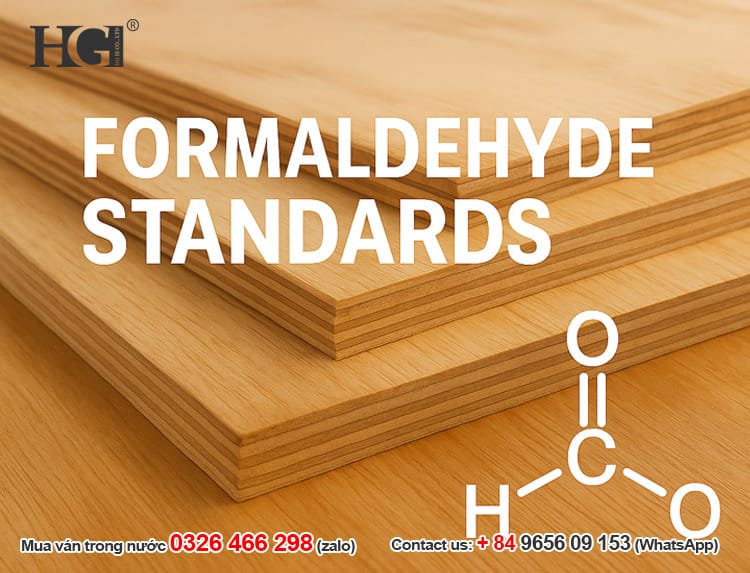In the engineered wood industry (plywood, MDF, HDF), formaldehyde is a key component in adhesives that bond wood fibers together. However, when its emission level exceeds safety limits, formaldehyde can negatively impact consumer health.
With decades of experience in producing and exporting plywood, HG Plywood emphasizes that understanding and applying the correct formaldehyde emission standards is crucial for ensuring product quality, protecting end-users, and maintaining international competitiveness.

1. What is Formaldehyde & Why Must It Be Controlled?
Formaldehyde (HCHO) is a volatile organic compound commonly used in industrial adhesives for wood-based panels. Excessive emissions can cause:
- Irritation of eyes, nose, and respiratory tract
- Headaches, fatigue, and dry cough
- Long-term health risks: The World Health Organization (WHO) classifies formaldehyde as a potential human carcinogen with prolonged exposure at high concentrations (WHO – IARC Monographs).
👉 This is why formaldehyde emission standards were developed — to regulate emissions in engineered wood products and protect public health.
2. Common Formaldehyde Standards Today
At HG Plywood, we comply with multiple formaldehyde standards depending on customer requirements and export markets:
| Standard | Emission Limit | Application | Reference |
|---|---|---|---|
| E0 | ≤ 0.07 ppm | Premium furniture | JIS A-1460 (Japan) |
| E1 | ≤ 0.14 ppm (Plywood) ≤ 0.10 ppm (MDF) | Europe, Vietnam | EN 717-1 (EU) |
| E2 | ≤ 0.38 ppm | Temporary construction, outdoor use | EN 717-1 (EU) |
| CARB Phase II / TSCA Title VI | ≤ 0.05 ppm (Hardwood Plywood) ≤ 0.11 ppm (MDF) | USA, Canada | EPA |
👉 Want to dive deeper? Read our full guide: “E0, E1, E2 Standards and Formaldehyde in Engineered Wood Panels – Are You Choosing Correctly?”
3. Formaldehyde Testing Methods
There are several methods to test formaldehyde emissions in wood products. The most widely recognized include:
- Chamber Test (EN 717-1, ASTM E1333): Measures emission levels in a controlled chamber.
- Desiccator Method (JIS A-1460): Uses a desiccator to absorb emissions.
- Gas Analysis: Direct measurement of emitted gases.
- FLEC Test: On-site testing for real-world applications.
At HG Plywood, every shipment is verified by independent laboratories before export to ensure compliance with international standards.
4. HG Plywood’s Commitment to Formaldehyde Safety
As a trusted plywood manufacturer, we prioritize both health safety and sustainability:
- Using ULEF adhesives (Ultra-Low Emitting Formaldehyde) to minimize emissions
- Sourcing raw materials from sustainably managed plantations
- Providing full certifications (E1, CARB) upon request
- Investing in green technology and developing formaldehyde-free alternatives
5. Tips for Choosing Engineered Wood Products
Whether you’re a furniture manufacturer, contractor, or end-user, here’s what you should keep in mind:
- Always request formaldehyde certificates (E1, CARB) from suppliers
- Prefer E1 or CARB-compliant panels for indoor applications
- Ensure proper surface finishing (lamination, edge-banding) to reduce emissions
- Maintain good ventilation in interior spaces
6. Conclusion
Understanding formaldehyde standards in plywood, MDF, and other engineered wood products is key to selecting materials that are safe, high-quality, and globally compliant.
At HG Plywood, we are committed to delivering plywood that meets the strictest standards (E0, E1, CARB, TSCA), serving both domestic and international markets with reliability and trust.
👉 Contact HG Plywood today for expert consultation and access to our internationally certified plywood products.
📞 Contact Information
H&G Import and Export Co., Ltd
🌏 Website: hgwoods.com
📞 Hotline: (+84) 9656 09 153 (WhatsApp)
📧 Email: hgplywood@gmail.com
🏭 Address: Dinh Xuyen, Gia Lam, Hanoi, Vietnam

Leave a Reply